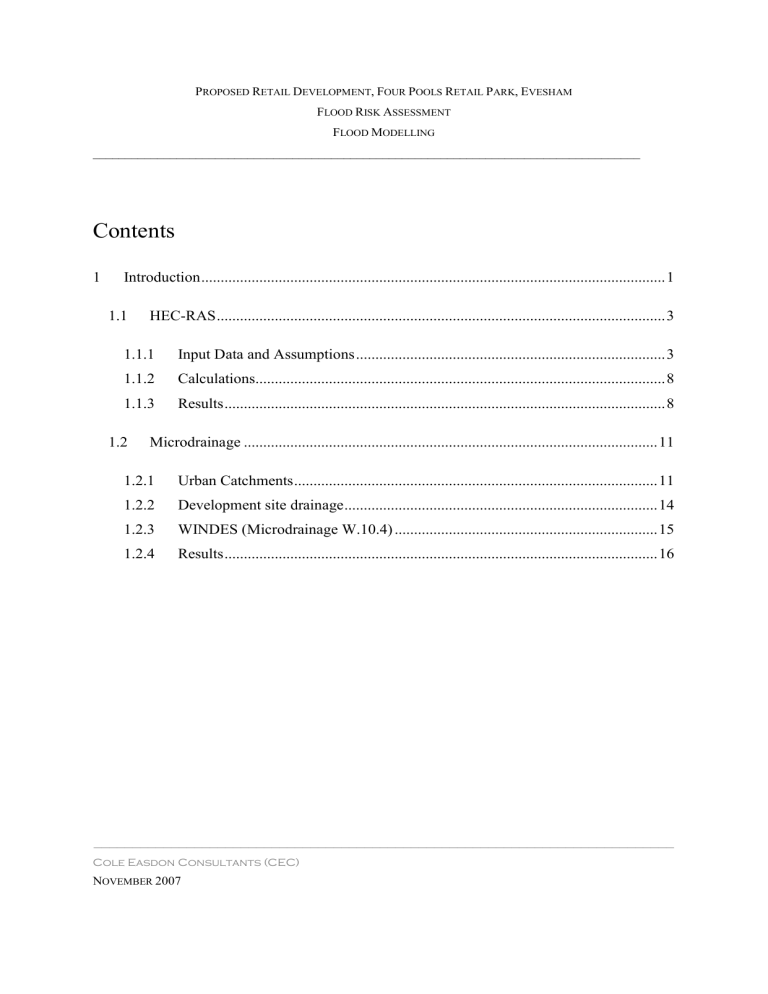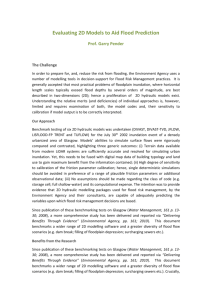Whole Doc

P ROPOSED R ETAIL D EVELOPMENT , F OUR P OOLS R ETAIL P ARK , E VESHAM
F LOOD R ISK A SSESSMENT
F LOOD M ODELLING
_____________________________________________________________________________________
Contents
___________________________________________________________________________
Cole Easdon Consultants (CEC)
N OVEMBER 2007
P ROPOSED R ETAIL D EVELOPMENT , F OUR P OOLS R ETAIL P ARK , E VESHAM
F LOOD R ISK A SSESSMENT
F LOOD M ODELLING
_____________________________________________________________________________________
1 INTRODUCTION
Flow modelling has been undertaken so as to determine the impact of flood flow on the development site. Careful consideration has been given to use of an appropriate modelling method, given the combination of input runoff from rural and urban catchments into the
Battleton Brook in the vicinity of the development site. Upstream of the development site, runoff from a rural catchment (261 hectares in size from FEH Handbook) enters the Battleton
Brook. Additionally, urban runoff from five separate sewer/ drain catchments discharges to the Battleton Brook in the vicinity of the development site, including runoff from the existing
Four Pools Retail Park. Discharge from all of these catchments has been simulated in the flow model. Refer to Figures 3 and Drawing No. 2409/ 504.
A combination of two mathematical modelling programs has been used (Microdrainage and
HEC-RAS) to analyse the impact of storm events with respect to the development site.
Microdrainage has been used for modelling of the urban sewer systems and, although it includes an open channel flow option, this flow calculation facility is limited and is not appropriate for use in floodplain modelling. HEC-RAS has been used for this element of the model instead so as to account for rural catchment flow.
The following sequence has been observed with respect to flow modelling:
1.
Peak rural flowrate has been determined using the FEH Handbook
2.
Peak urban flowrates have been determined using Microdrainage, based on sewer/ drain records.
3.
A HEC-RAS model has been built using topographical survey cross section and culvert data. The model has then been run for a range of different flow scenarios using the rural and urban peak flow inputs. For the purpose of modelling it has been assumed that rural and urban peak flows occur simultaneously in the vicinity of the
___________________________________________________________________________
Cole Easdon Consultants (CEC)
- 1 -
D ECEMBER 2007
P ROPOSED R ETAIL D EVELOPMENT , F OUR P OOLS R ETAIL P ARK , E VESHAM
F LOOD R ISK A SSESSMENT
F LOOD M ODELLING
_____________________________________________________________________________________ development site. This, so as to determine a worst case flooding scenario for each simulation event.
4.
For each HEC-RAS modelled flood event scenario, the energy height at the site drainage/ Culvert 2 connection point was obtained from the HEC-RAS model and used as the downstream boundary condition for the Microdrainage site drainage model so as to determine the extent of urban drainage flooding on the development site.
Conservative estimates have been made regarding assumptions and input parameters used in respect of the flow model. This, so as to reduce any possibility of “under estimation” of the impact of flood flow on the development site. All input flowrates are based on peak flow.
___________________________________________________________________________
Cole Easdon Consultants (CEC)
- 2 -
D ECEMBER 2007
P ROPOSED R ETAIL D EVELOPMENT , F OUR P OOLS R ETAIL P ARK , E VESHAM
F LOOD R ISK A SSESSMENT
F LOOD M ODELLING
_____________________________________________________________________________________
1.1
HEC-RAS
HEC-RAS 3.1 (Hydraulic Engineering Centre’s River Analysis System) is a one-dimensional hydraulic model. It supports water surface profile calculations for steady, gradually varied flow in natural or constructed channels. Subcritical, supercritical and mixed flow can be calculated. Water surface profiles are computed from one cross section to the next by solving the Energy equation with an iterative procedure.
1.1.1
Input Data and Assumptions
Geometry
Input geometry has been based on surveyed cross section data. Refer to Drawing 2409/ 503.
Using these cross sections, additional cross sections have been interpolated and used in the
modelling calculations (Figure 1). Culvert 2 has been modelled by inputting twin 1200mm
dia. pipes with an equivalent length based on hydraulic properties (Darcy-Wiesbach equation) and local losses.
___________________________________________________________________________
Cole Easdon Consultants (CEC)
- 3 -
D ECEMBER 2007
P ROPOSED R ETAIL D EVELOPMENT , F OUR P OOLS R ETAIL P ARK , E VESHAM
F LOOD R ISK A SSESSMENT
F LOOD M ODELLING
_____________________________________________________________________________________
Culvert 2
Culvert 1
Figure 1 Culvert 1/ 2 Model: HEC-RAS schematic layout
Hydraulics
The steady flow component of the program has been used. The basic computational procedure is based on the solution of the one-dimensional energy equation. Energy losses are evaluated by friction (Manning's equation) and contraction/expansion (coefficient multiplied by the change in velocity head). Different values of Manning’s roughness have been used for
particular elements of the model. Refer to Table 1. Contraction and expansion coefficients
used are 0.1 and 0.3, respectively. Entrance and exit loss coefficient used at the culvert locations are 0.5 and 1.0 respectively.
___________________________________________________________________________
Cole Easdon Consultants (CEC)
- 4 -
D ECEMBER 2007
P ROPOSED R ETAIL D EVELOPMENT , F OUR P OOLS R ETAIL P ARK , E VESHAM
F LOOD R ISK A SSESSMENT
F LOOD M ODELLING
_____________________________________________________________________________________
Model element
Open watercourse (main channel)
Manning’s ‘n’
0.03
Open watercourse (overbank) 0.05
Box culverts (base)/ Piped culvert
Box culverts (Walls & soffit)
Table 1 Manning's values
0.015
0.01
Figure 2 Photo of Culvert 2 upstream open channel
Four fluvial flood events were modelled: 1:20 yr, 1:100 yr, 1:100 yr+20% climate change and
50% blockage at the upstream end of Culvert 2 for the 1:100 yr+20% event using appropriately calculated flow inputs for each modelled scenario. Input flow rates comprise of
the peak rural flow from the FEH catchment upstream of the development site (Table 2) plus
the urban storm drainage networks discharging to the modelled system. The rural flow
___________________________________________________________________________
Cole Easdon Consultants (CEC)
- 5 -
D ECEMBER 2007
P ROPOSED R ETAIL D EVELOPMENT , F OUR P OOLS R ETAIL P ARK , E VESHAM
F LOOD R ISK A SSESSMENT
F LOOD M ODELLING
_____________________________________________________________________________________
component has been based on the FEH hydrograph for the catchment area. Table 3 shows
how the flow rate increases along the modelled watercourse in response to urban contributions.
1:20 yr 1:100 yr 1:100 yr + 20%
Rural flow (m³/s)
2.3 3.4 4.08
Table 2 Upstream rural flow
Boundary conditions
Peak flow based on the FEH catchment (Figure 3) has been used as the upstream boundary
condition. At the downstream end, water levels have been set as the boundary condition to simulate the downstream water levels in the Battleton Brook. The assumed water levels are
___________________________________________________________________________
Cole Easdon Consultants (CEC)
- 6 -
D ECEMBER 2007
P ROPOSED R ETAIL D EVELOPMENT , F OUR P OOLS R ETAIL P ARK , E VESHAM
F LOOD R ISK A SSESSMENT
F LOOD M ODELLING
_____________________________________________________________________________________
Figure 3 FEH Catchment
___________________________________________________________________________
Cole Easdon Consultants (CEC)
- 7 -
D ECEMBER 2007
P ROPOSED R ETAIL D EVELOPMENT , F OUR P OOLS R ETAIL P ARK , E VESHAM
F LOOD R ISK A SSESSMENT
F LOOD M ODELLING
_____________________________________________________________________________________
Boundary location
Upstream flow (m³/s)
1:20 yr
2.5
Flood Return Event
1:100 yr
3.6
1:100 yr +
20%
4.28
5.48 Flow upstream of Culvert 2 (m³/s)
Flow downstream of Culvert 2
(m³/s)
3.7
4
4.8
5.1
Downstream channel water level
(m OD)
27.75
Table 3 Boundary conditions
28.00
5.78
28.30
20% climate change
Climate change has been applied to the 1:100 year flood flow by increasing the peak rural flow component by 20%.
50% blockage
To simulate a 50% blockage scenario at Culvert 2, the twin pipes have been modelled as being 50% blocked over the entire culvert length.
1.1.2
Calculations
The steady flow simulation model has been solved using the default calculation settings.
1.1.3
Results
The modelling results provide the hydraulic characteristics for the culverted watercourse at
any point (Refer to Figure 4 and Table 5). The calculated water levels (for the different
modelled flood event scenarios) at the location of the existing site drainage connection to
___________________________________________________________________________
Cole Easdon Consultants (CEC)
- 8 -
D ECEMBER 2007
P ROPOSED R ETAIL D EVELOPMENT , F OUR P OOLS R ETAIL P ARK , E VESHAM
F LOOD R ISK A SSESSMENT
F LOOD M ODELLING
_____________________________________________________________________________________
Culvert 2 have been used as the downstream boundary condition input into the Microdrainage
model of the existing site drainage system (Four Pools Retail Park). (Refer to Table 4).
The modelled results also show that the modelled culverts act as constrictions to flow during extreme flood events. Similar impacts can be expected on downstream culverts. This has been taken into account at the downstream boundary.
31
1:20 yr 1:100 yr 1:100 yr + 20 % 50% blockage
Energy level
(m OD)
28.23 28.67 29.01 29.32
Table 4 Energy levels at site drainage connection to Culvert 2
30
29
28
27
100 200 300
Main Channel Distance (m)
400
Figure 4 HEC-RAS modelled output: Long Section
500
___________________________________________________________________________
Cole Easdon Consultants (CEC)
- 9 -
D ECEMBER 2007
P ROPOSED R ETAIL D EVELOPMENT , F OUR P OOLS R ETAIL P ARK , E VESHAM
F LOOD R ISK A SSESSMENT
F LOOD M ODELLING
_____________________________________________________________________________________
Cross section
1:20yr 1:100yr 1:100yr+20% 50% blockage
Water Surface Elevation (m OD)
1 29.03 29.53 30.07 30.47
2
5
6
7
28.68
28.73
28.62
28.58
29.52
29.52
29.27
29.27
30.06
30.06
29.74
29.74
30.47
30.47
30.15
30.15
8
9
28.57 29.27
28.57 29.26
29.74
29.74
30.15
30.15
10 27.91 28.12
11 27.77 28.01
28.34
28.29
28.34
28.29
12 27.75 28.00 28.30 28.30
Table 5 HEC-RAS results – Water Surface Levels
___________________________________________________________________________
Cole Easdon Consultants (CEC)
- 10 -
D ECEMBER 2007
P ROPOSED R ETAIL D EVELOPMENT , F OUR P OOLS R ETAIL P ARK , E VESHAM
F LOOD R ISK A SSESSMENT
F LOOD M ODELLING
_____________________________________________________________________________________
1.2
Microdrainage
Microdrainage software has been used to:
1.
Evaluate discharges from urban catchments that discharge to the Culvert 1/ 2 drainage system.
2.
Establish the extent of flooding at the development site relating to the site drainage system.
1.2.1
Urban Catchments
Based on public sewer records (Severn Trent Water), sewer systems discharging to the modelled Culvert 1/ 2 system have been analysed. Five drainage systems have been identified as connecting to the Culvert 1/ 2 system, one upstream of Culvert 1, two connections into
Culvert 2 and two downstream of Culvert 2 (Refer to Figure 5).
Catchment 1
Discharge from Catchment 1 has been assumed as capacity flow of the last downstream pipe.
This is a conservative estimate. In reality, the discharge from this catchment is probably smaller. The next upstream pipe is much larger. It is assumed that this is an oversize pipe for the purpose of attenuation. It is probable that a flow control is sited on the downstream end of the tank sewer, limiting piped discharge to the modelled Culvert 1/ 2 system.
Catchment 2, 3, 4 and Development Site
For the range of modelled storm events, it has been found that the flow in the sewers is pressured (surcharged pipes) and the discharge is fully dependant on the hydraulic gradient.
The analysis concluded that the hydraulic gradient is highest for the 1:20 year flood event.
___________________________________________________________________________
Cole Easdon Consultants (CEC)
- 11 -
D ECEMBER 2007
P ROPOSED R ETAIL D EVELOPMENT , F OUR P OOLS R ETAIL P ARK , E VESHAM
F LOOD R ISK A SSESSMENT
F LOOD M ODELLING
_____________________________________________________________________________________
The 1:20 year discharges from Catchments 2, 3 and 4 have therefore been used as input into the steady state HEC-RAS model for all modelled storm events. The discharges are
Catchment 1 2 3 4 Development Site
Discharge (m³/s) 0.2 1.0 0.2 0.1
0.2
Table 6 Urban Catchment Peak Discharges (1:20 year event)
___________________________________________________________________________
Cole Easdon Consultants (CEC)
- 12 -
D ECEMBER 2007
P ROPOSED R ETAIL D EVELOPMENT , F OUR P OOLS R ETAIL P ARK , E VESHAM
F LOOD R ISK A SSESSMENT
F LOOD M ODELLING
_____________________________________________________________________________________
Figure 5 Urban Catchment Analysis
___________________________________________________________________________
Cole Easdon Consultants (CEC)
- 13 -
D ECEMBER 2007
P ROPOSED R ETAIL D EVELOPMENT , F OUR P OOLS R ETAIL P ARK , E VESHAM
F LOOD R ISK A SSESSMENT
F LOOD M ODELLING
_____________________________________________________________________________________
1.2.2
Development site drainage
The HEC-RAS model of the complete drainage system was built up to investigate the impact of storm events on the existing site drainage and to establish the extent of any fluvial flooding.
For each modelled flood event scenario, the energy height at the site drainage/ Culvert 2 connection point was obtained from the HEC-RAS model and used as the downstream boundary condition for the Microdrainage site drainage model so as to determine the extent of urban drainage flooding on the development site.
Figure 6 Photo of development site
___________________________________________________________________________
Cole Easdon Consultants (CEC)
- 14 -
D ECEMBER 2007
P ROPOSED R ETAIL D EVELOPMENT , F OUR P OOLS R ETAIL P ARK , E VESHAM
F LOOD R ISK A SSESSMENT
F LOOD M ODELLING
_____________________________________________________________________________________
1.2.3
WINDES (Microdrainage W.10.4)
The WinDes tool from Microdrainage has been used to model urban drainage discharge. The
input parameters (global variables) have been set up as shown in Table 7 below.
Region
Return Period (yrs)
M5-60 (mm)
Ratio R
Volumetric Runoff Coef
Profile Type
PIMP (%)
Areal Reduction Factor
FSR - England & Wales
18.000
0.365
0.840
Winter
100
1.000
Critical Storm Duration (mins)
Hot Start
Manhole Headloss Coefficient
MADD Factor * 10m³/ha Storage
Foul Sewage/Hectare (l/s) 0
Additional Flow - % of Total Flow 0
Number of Input Hydrographs
Number of Time/Area Diagrams
0
0
30
0
0.500
2.000
Number of Bifurcations
Number of Overflows
Number of Off-Line Controls
Number of On-Line Controls
0
0
0
0
Table 7 Microdrainage – Input Global Variables
Rainfall events as shown in Table 8 have been used to simulate flood events.
Rainfall periodicity Flood event periodicity
1:35 year 1:20 year
1:140 year 1:100 year
Table 8 Event periodicity
___________________________________________________________________________
Cole Easdon Consultants (CEC)
- 15 -
D ECEMBER 2007
P ROPOSED R ETAIL D EVELOPMENT , F OUR P OOLS R ETAIL P ARK , E VESHAM
F LOOD R ISK A SSESSMENT
F LOOD M ODELLING
_____________________________________________________________________________________
All network details have been based on site survey and public sewer records. In order to simulate the connection of the existing site drainage system to the 1200mm dia. culvert pipe
(Culvert 2), the “Surcharge Outfall” option has been used for the last connecting pipe (from the site) with a water level obtained from the HEC-RAS simulation.
1.2.4
Results
The results show that flow within the existing site drainage system is fully dependant on the height of the water energy line in Culvert 2 at the point of connection. For fluvial flood events with a magnitude less than the 1:100 year event, the site drainage will surcharge but will not flood. However, the analysis has found that the capacity of the site drainage system will be exceeded during fluvial flood events that exceed the 1:100 year event in magnitude, and manhole flooding will occur. However, only localised ponding will occur under such circumstances due to site topography. The site is graded such that, in the event of site drainage flooding, the overflow will be routed towards Four Pools Lane via the main site access. Flow will then be routed along Four Pools Lane and towards the open watercourse.
The results show that fluvial flooding of the development site does not occur for the modelled flood event scenarios.
___________________________________________________________________________
Cole Easdon Consultants (CEC)
- 16 -
D ECEMBER 2007







